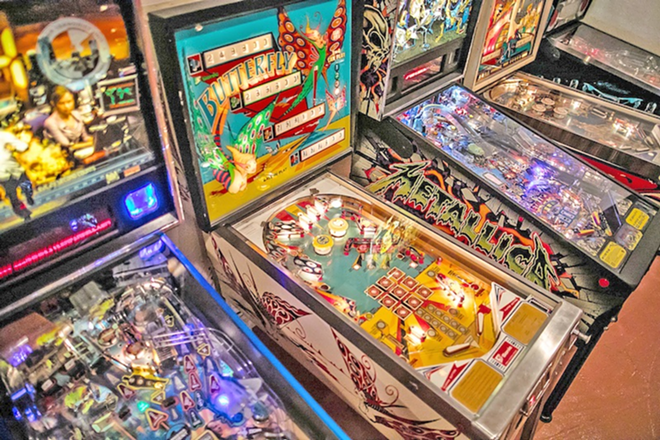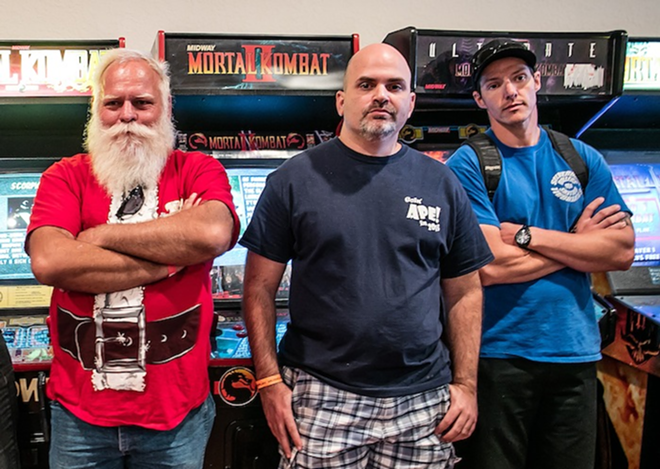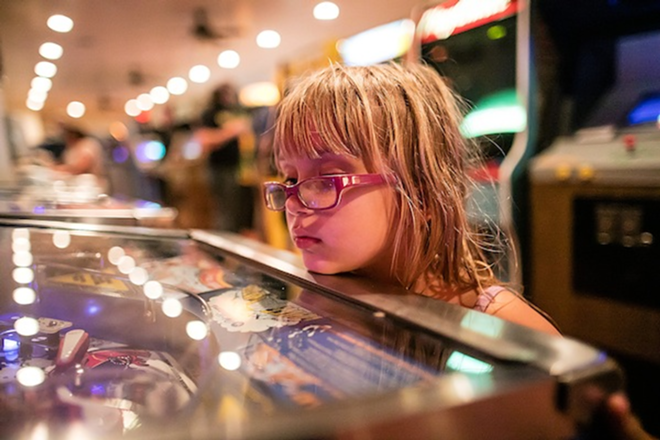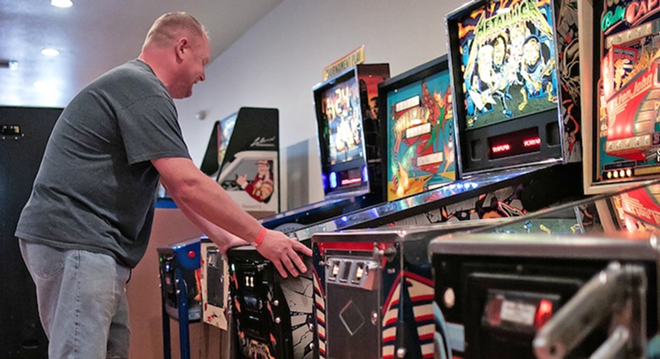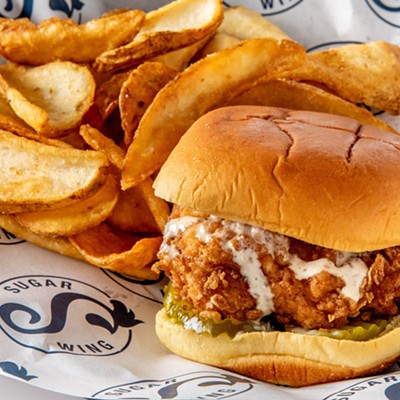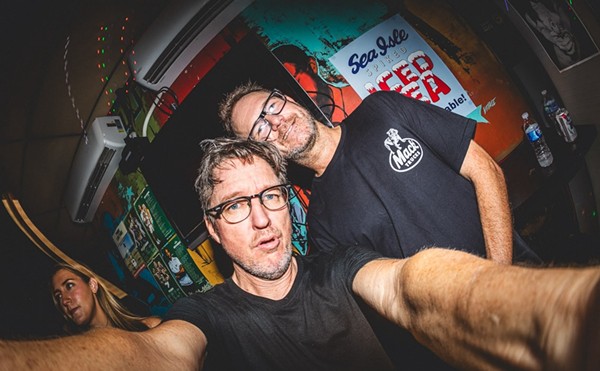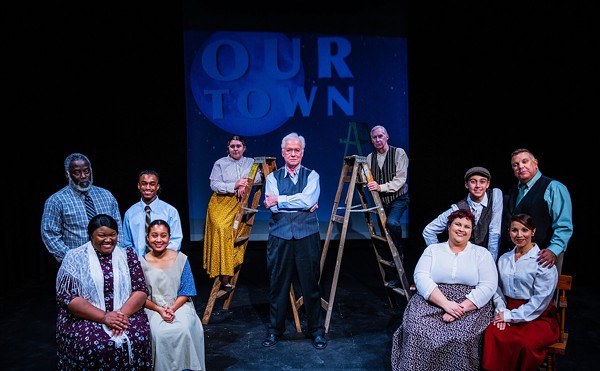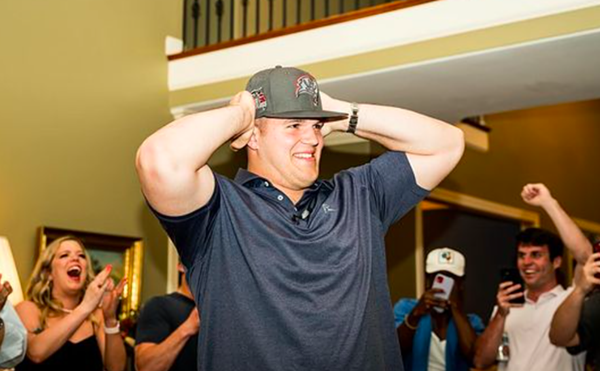It’s a Saturday, but downtown Tarpon Springs is sodden and silent after three days of rain. The only real sign of life is a smattering of people, mostly in their thirties and beyond, milling around in front of a bright yellow and red storefront. From the doorway behind them, you can just hear it — the bells, clacks, and bleeps of yesteryear.
Through that door, inside Replay Amusement Museum, the noise is deafening, and the joy is palpable. Adults, kids, and more than a few grandmas jockey for their turns in front of stand-up game consoles, slapping fat red buttons and talking trash to machine and human alike. There’s a little Gradius, some Street Fighter — but most of the crowd’s energy is directed to the dozens of pinball machines lining Replay’s long brick walls: Addams Family, Arabian Nights, White Water.
Those names might not ring out like their digital cousins’ — certainly not on a weekend when Pac-Man is co-starring in an Adam Sandler disaster movie (in every sense). But Replay, and its collection of dozens of “pins” stretching back to the 1970s, are part of a nationwide movement.
The players
Past Replay’s rabid arcade abandon is a corner of quieter intensity. As judges with clipboards look on, a dozen or so players take turns at a bank of five pinball machines, tracking silver balls with the scowls of pool hustlers. They cringe and deflate at every “drain,” or lost ball — then go right back for more.
This is competitive pinball — a small stop on the year-long circuit of the IFPA (International Flipper Pinball Association), a body resurrected from the dead over the past decade. Most of Florida’s top players are here, including Jeff Palmer, with his epic beard and flowing locks, and his gangly, daydreaming teenage son Atticus. Atticus was the first Florida state pinball champ in 2014, when he was just 14.
Then there’s Sebastian Bobbio — the top-ranked player in Florida, at least for the moment. He’s wrestling with The Shadow, a pin that has long outlived the Alec Baldwin vehicle that inspired it. He crouches like a tiger, his face just inches from the glasstop as he twists and cajoles the machine through its paces.
Since every pinball table has a different scoring scale — 20 million points might be great for one pin, awful for another — players jockey for rank on each of the five tables. Those results earn points towards global IFPA rankings that include Swedish, Dutch, Spanish, and Canadian players, in addition to a solid American presence.
Some might still think competing at pinball is an oxymoron, and it was outlawed as gambling for decades in many states. But the modern game demands sharp reflexes, precise aim, and deep knowledge of each table’s intricate modes and strategies. Some rulesets are staggeringly arcane; for example, a machine honoring AC/DC rewards players for triggering the band’s albums in the order they were released.
They might be competing, but the players cheerfully trade advice. “Instead of hitting with the upper flipper,” Atticus confides knowingly in a competitor, “just hold the upper flipper and it’ll roll over.” His listener, a hefty guy in a fitted cap, offers his own advice in return:
“Stay humble. The machine wants you to stay humble.”
The collectors
Not everybody’s a competitor — in fact, some of Tampa Bay’s most influential pin fanatics don’t play for points.
“It’s too much pressure,” says Brian Cheaney, co-founder of Replay. Cheaney started the museum/arcade after accumulating so many machines that he couldn’t keep them to himself.It’s a sickness plenty of pinball buffs share. They pick up one machine, then two, and before long, there’s an entire wing of the house dedicated to antiquated amusements.
Each pinball machine is not just one work of art, but several, from fantastical backglasses to elaborate props. Many old tables have doubled or tripled in value in the last five years. Working pins from the 1970s and early 1980s — DMDs, or Dot Matrix Displays — can be had for around a thousand bucks, while so-called “Solid State” games from the 1990s typically run to five or six grand. Demand is so high that classic tables like the beloved Medieval Madness are actually being reissued, and can be yours for a cool $8,000.
But for kids who grew up on pinball, those are just numbers. Ben Chertok, who briefly dealt machines out of his Central Oddities antique shop in St. Pete, started collecting out of nostalgia for childhood summers at arcades in Maine. He now has about 40 machines in various states of repair.
He also knows why a new generation of younger players are entranced by pins, even in the era of the Xbox: It’s all about the physicality, the ball that has a life of its own, the real-world unpredictability.
“I see kids that don’t even know that they’re missing that dimension,” says Chertok. “And then when they do [get it], they’re kicking it, punching it!” There is obvious approval in his voice as he discusses children mauling valuable antiques.
When the intricate, lovingly abused machines inevitably break down, guys like Chertok and Cheaney can do some repairs themselves — or they can turn to a professional restorer like Jeff Miller. Tall and talkative, Miller may be the most important national pinball figure in Tampa Bay.
Billing himself as the Pinball Pimp, Miller restores machines from all across the country, and produces the best art stencils in a thriving accessory market. Fans are increasingly treating pinball machines like classic cars, he says, restoring them meticulously to their original state, or modifying them with high-end accessories including, literally, bells and whistles.
Miller’s a little wary of pinball’s surging popularity, mostly because he can’t pick up machines as easily as he once could. “The hobby has gotten so ridiculous, as soon as anything hits Craigslist, it’s gone in five minutes.”
But he expects that, in our digital world, wood and steel are going to stay entrancing.
“There’s no code on that ball. This is a real ball coming off a real flipper with real speed, and you gotta use your eye to hit that,” he says.“You just can’t get that from a computer and iPad.
“It’s a whole experience.”
HOW NOT TO SUCK
Practice at home. Buying multiple pinball machines isn’t practical for most of us. But Farsight Studio’s Pinball Arcade mobile app features dozens of detailed simulations. No sim can capture the subtleties of real-life pinball, but these will at least warm you up.
Get strategic. Every pinball machine has specific tactics. The Professional Amateur Pinball Association has a series of videos breaking down how to max out your multiballs and jackpots on classic tables. (www.youtube.com/user/PAPApinball).
Get in the zone. Atticus Palmer wears headphones while competing, and says music helps him maintain focus. His favorite jam is Rick Astley’s “Never Gonna Give You Up.” (This is, apparently, not a joke.)
And the most important tip, according to Jeff Palmer?
“Shoot what’s blinking.”
WATCH, READ, LEARN
Special When Lit: A Pinball Documentary Available on Hulu and Youtube, this documentary is a comprehensive historical survey, and an insightful social analysis of a bygone era.
Tilt: The Battle to Save Pinball Focused on the fate of the Williams pinball unit, this film (another doc) is inside baseball for serious pin nerds — but also a dramatic cliffhanger about ambition and business.
Pinball! by Roger C. Sharpe This now-rare book is still the most authoritative on the early history of the game. Its author is a pinball designer also famous for testifying before the New York City Council in 1976 — by executing a series of tricky shots, he proved that pinball was a game of skill, not a form of gambling.

